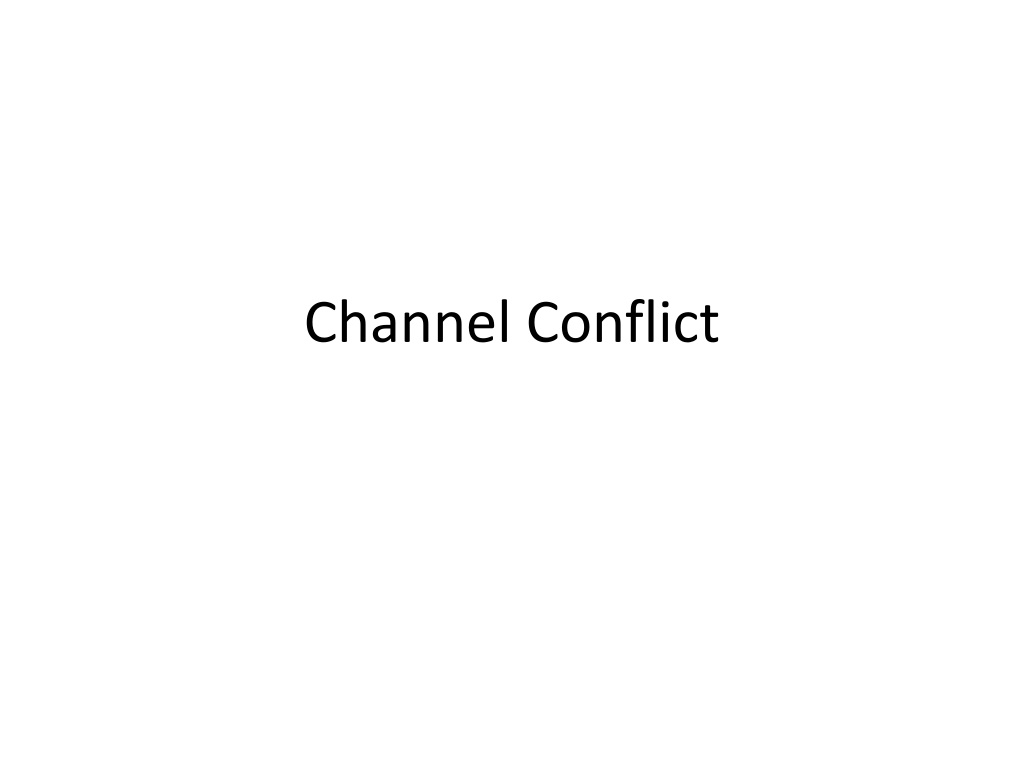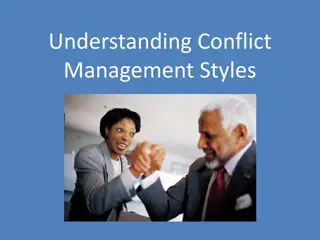Understanding Channel Conflict in Marketing
Channel conflict in marketing refers to disputes between different channel partners, such as manufacturers, wholesalers, and retailers, that impact business operations and goals. These conflicts can arise at different levels within the distribution channel, leading to issues like price wars, customer dissatisfaction, and brand perception challenges.
Download Presentation

Please find below an Image/Link to download the presentation.
The content on the website is provided AS IS for your information and personal use only. It may not be sold, licensed, or shared on other websites without obtaining consent from the author. Download presentation by click this link. If you encounter any issues during the download, it is possible that the publisher has removed the file from their server.
E N D
Presentation Transcript
Definition: Channel conflict can be explained as any dispute, difference or discord arising between two or more channel partners, where one partner s activities or operations affect the business, sales, profitability, market share or similar goal accomplishment of the other channel partner. Types of Channel Conflict The channel conflict can be classified majorly into the following four categories depending upon its flow and the parties involved: Vertical Level Conflict In the vertical level conflict, the channel partner belonging to a higher level enters into a dispute with the channel member of a lower level or vice-versa. For instance, channel conflict between dealers and retailers or wholesalers and retailers. Horizontal Level Conflict The conflict among the channel partners belonging to the same level, i.e., issues between two or more stockists or retailers of different territories, on the grounds of pricing or manufacturer s biases, is termed as horizontal level conflict.
Inter-type Channel Conflict These type of conflicts commonly arise in scrambled merchandising, where the large retailers go out of their way to enter a product line different from their usual product range, to challenge the small and concentrated retailers. Multi-channel Level Conflict When the manufacturer uses multiple channels for selling the products, it may face multi-channel level conflict where the channel partners involved in a particular distribution channel encounters an issue with the other channel. Causes of Channel Conflict Role Ambiguity: The uncertain act of an intermediary in a multi-channel arrangement may lead to disturbance in the channel of distribution and cause conflict among the intermediaries. Incompatible Goals: When the manufacturer and the intermediaries do not share the same objectives, both work in different directions to meet their ends, this results in channel conflict.
Marketing or Strategic Mis-Alignment: Sometimes, two-channel partners promote the manufacturer s product in a different manner, which created two different images of the same product in the consumers mindset, which creates conflicting brand perception. Difference in Market Perception: The manufacturer s understanding of the potential market and penetration into a specific region or territory, may vary from the perception of the intermediaries, which can create conflict and reduce the intermediary s interest in capturing that particular market. Change Resistant: When the channel leader plans to modify the distribution channel, the intermediaries may or may not accept this change. Thus, it may result in a condition of discord or non-cooperation. Improper Geographic or Demographic Distribution: If the sales territory has a narrow consumer base, and the channel leader allows many selling partners, they tend to lose interest soon because of low profit and limited sales.
Consequences of Channel Conflict Price Wars: Due to channel conflict, the partners compete with each other on the grounds of price, and therefore, the consumer may defer the purchase searching for the best deal. Customer Dissatisfaction: If there exists a channel conflict, then the distributors or retailers may show much interest in the company s products and resist to assist the consumers, which results into their resentment towards the brand. Sales Deterioration: Conflicts can adversely affect the sales of the products due to the decline in distributors interest and an increasing number of consumers shifting to competitors products. Distributors Exit: For the manufacturers, it is essential to retain the distributors or partners to increase product sales. When there is a channel conflict, the chances of various distributors leaving the channel increases. Poor Public Relations: The unsatisfied distributors may negatively publicize the brand and its products as a result of manufacturer s unhealthy public relations with them.
Channel Conflict Management It is a universal fact that the conflicts cannot be eliminated, though these can be handled smartly to reduce its negative impact on business. Mediation, Arbitration and Diplomacy To resolve a dispute, the manufacturer can adopt the strategy of intervention where a third person intervenes to create harmony. The other option is arbitration, where an arbitrator listens to the argument of the parties involved in a conflict and declares a decision. Or, the parties can resort to diplomacy where the representatives of both the parties conversant and find a solution. Co-optation The manufacturer should hire an expert who has already gained experience in managing the channel conflicts in other organizations, as a member of the grievance redressal committee or board of directors, for addressing such conflicts. Dealer Councils and Trade Associations To handle the horizontal or vertical conflicts, the manufacturer forms a dealer council where the dealers can unanimously put up their problems and grievances in front of the channel leader. To bring in unity among the channel partners or intermediaries, they can be added as members in trade association which safeguards their interest.
Superior Goals Establishing a supreme goal of the organization and aligning it with the individual goals or objectives of the channel partners, may reduce the channel conflicts. Regular Communication The channel leader should take regular feedback from the channel partners through formal and informal meetings to know about market trends and dynamics. Also, the channel partner s issues and conflicts can be addressed through frequent interactions. Legal Procedure When the conflict is critical and uncontrollable by the channel leader, the aggrieved party can seek legal action, by filing a lawsuit against the accused party. Fair Pricing Most of the channel conflicts are a result of the price war, and therefore, these can be resolved by ensuring that products are equally priced in all the territories and a fair margin is provided to the channel partners.























